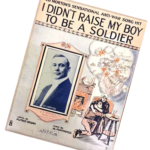On 28 June 1914 Archduke Franz Ferdinand, heir to the throne of Austria, was assassinated in Sarajevo by Serbian nationalists. This created a political July Crisis ending with Austria, supported by Germany, sending an ultimatum to Serbia; Russia, encouraged by France, supported Serbia. Armies were mobilized and in early August began marching across borders. Germany invaded Belgium, provoking Great Britain to declare war in response. Afraid to look weak if they backed down, the great powers of Europe started what quickly became known as The Great War.
MOST AMERICANS PREFER PEACE
Wilson was supported by a strong pacifist sentiment in the U.S., exemplified by these women peace marchers in New York on 29 August, and the popularity of the anti-war song “I Didn’t Raise My Boy To Be A Soldier”


PRESIDENT WILSON PROCLAIMS

“The United States must be neutral in fact as well as name during these days that are to try men’s soul. We must be impartial in thought as well as in action,…”
ROOSEVELT URGES PREPAREDNESS

Former president Theodore Roosevelt wrote privately to one of Wilson’s advisors, urging him: “I wish you would get him to assemble the fleet and put it in first-class fighting order, and to get the army up to the highest pitch at which it can now be put. No one can tell what this war will bring forth.”
SOME AMERICANS WANT TO HELP

Despite U.S. neutrality, the ship SS Red Cross, nicknamed “Mercy Ship,” left for Europe with medical supplies and 170 surgeons and nurses such as these Red Cross workers in San Francisco. They treated the sick and wounded of both sides impartially.

1914 War Begins In Europe Banner on view in the Veterans Building Lobby


